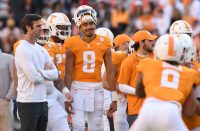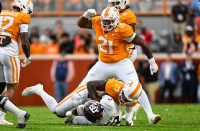Tennessee is replacing its starting quarterback, tailback, and number one wide receiver. An ideal combination this is not, especially when all of them went in the NFL Draft. We won’t know what we’re getting in the trade from Josh Dobbs to Quinten Dormady and/or Jarrett Guarantano until we see it. But the best way to help a new quarterback is to get productive play from your starting tailback and number one wide receiver.
We know the names will be John Kelly and Jauan Jennings. The latter had the two most satisfying plays of the 2016 season. The former actually out-gained both Jalen Hurd and Alvin Kamara last season on fewer carries than both of them (what would the odds have been on that stat this time last year?). Granted, Kelly had no meaningful carries against Virginia Tech, Florida, Georgia, or Alabama. But he still averaged 6.43 yards per carry on the year, good for 43rd nationally.
Kelly’s productivity and a deep offensive line make the running game a lesser concern. I think the biggest question with Kelly actually ties directly into the questions about the passing game.
Tennessee has thrown to their running backs more than any team in the SEC in each of the last two years. In 2015 it was 21% of the time, and the Vols almost hit that number again last year (individual target rates from Football Study Hall):
| Team | RB Target Rate |
| Tennessee | 20.6% |
| LSU | 16.3% |
| Florida | 14.9% |
| South Carolina | 13.1% |
| Auburn | 12.8% |
| Vanderbilt | 11.9% |
| Georgia | 10.3% |
| Alabama | 10.2% |
| Arkansas | 9.1% |
| Texas A&M | 9.0% |
| Ole Miss | 8.4% |
| Mississippi State | 8.1% |
| Kentucky | 7.1% |
| Missouri | 4.0% |
When the percentage was so high in 2015, we wondered if it represented the lack of a true number one receiver and/or downfield threat, or perhaps Mike DeBord’s conservative fingerprints on Josh Dobbs. But last year all those options faded: Josh Malone was a clear number one, the Vols hit 50 20+ yard passes, and Dobbs became the highest drafted Vol quarterback that wasn’t Manning or Shuler.
But still, Tennessee went to their backs 20.6% of the time, far more than any other SEC team. So now the question shifts: were these numbers a byproduct of having Alvin Kamara on the roster, or will this still be a focal part of Butch Jones’ offense with a new quarterback and a new coordinator?
Kamara was the target on 12.6% of Dobbs’ passes in 2015 and 14.3% last year. Both numbers led the SEC among running backs. Can John Kelly fill at least one of those shoes? He didn’t get much opportunity to do so last year: he caught only six passes and no more than one in any game.
If the running back isn’t going to be a focal point of the passing game, where will those targets go?
Here’s how Tennessee’s passes were distributed last season:
| Player | Target Rate |
| Malone | 20.7% |
| Jennings | 17.4% |
| Kamara | 14.3% |
| Croom | 8.8% |
| Wolf | 8.8% |
| J. Smith | 8.3% |
| Byrd | 6.9% |
| Hurd | 4.1% |
| P. Williams | 3.3% |
| B. Johnson | 2.5% |
| J. Kelly | 2.2% |
Jennings made a big leap last year after being targeted just 6.2% of the time in 2015. As he becomes the new number one, Tennessee will need a number two to emerge with or without a strong contribution out of the backfield. And if it’s without, they’ll need a number three.
We’ve seen Tennessee’s passing game adapt under Jones in the past when it comes to top of the statistical leaderboard: in 2014 Pig Howard was the number one option out of the slot (54 catches for 618 yards), but Jalen Hurd was still third on the team in receptions with 35. Same for Rajion Neal in 2013, third on the team with 27 catches. Whether Worley or Dobbs, Bajakian or DeBord, throwing to the backs has been high on Butch’s priority list.
I actually think John Kelly will do quite well in this regard when given the chance. The bigger question may be for Ty Chandler or Carlin Fils-aime; history suggests whoever gets the number two reps is still going to get plenty of opportunities coming out of the backfield as well.
Maybe part of playing a new quarterback will include going downfield even more and not having to rely so much on the running backs in the passing game. It’ll be telling to watch early in the season to see how often the Vols look their way. Either way and especially if Tennessee goes downfield more, they’ll need a number two wide receiver to step up to fill in the gap.



